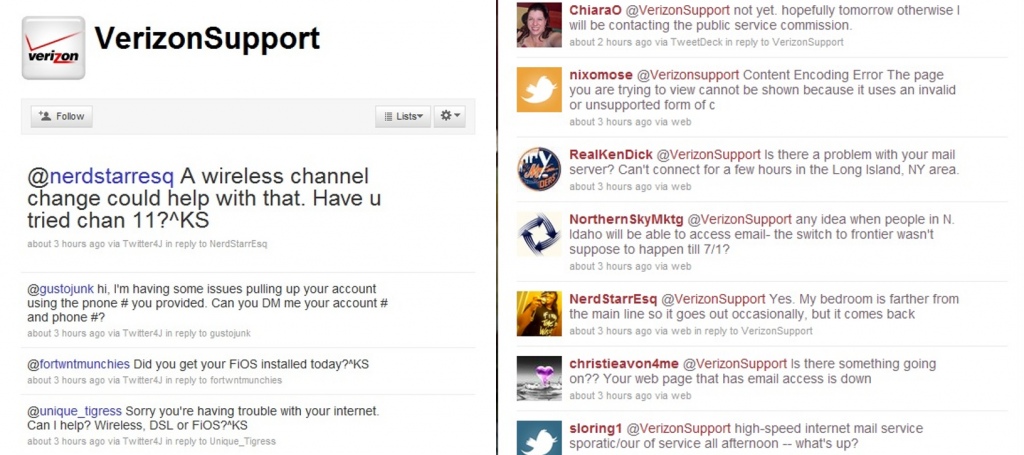After my Verizon e-mail went down for several hours yesterday, I checked the Web 2.0 “newspaper”: Twitter. I quickly discovered many tweets and even a few blog posts, such as Verizon Email Outage: Twitter and Central for Webmail, about the outage, which appeared to be national in scope.
To my surprise, however, @Verizon, the official Verizon corporate Twitter account, and @VerizonSupport, the official Verizon customer service Twitter account, weren’t acknowledging the outage. Take a look at the side-by-side screen shots below of what @VerizonSupport contained in response to customers (including me) sending out public tweets asking for information (you can click on the image to view a higher-resolution version).
The last question @VerizonSupport answered for the night was in response to @nerdstarresq’s installation problem, even though customer questions immediately before were about the outage. @Verizon was equally Orwellian with tweets, such as “PODCAST: Our Chief Sustainability Officer on Green Is Good radio show: http://bit.ly/c5pNCA^ac” and “Ck out latest Twitter feature on FiOS.When Tweeting via the TV it now says “via FiOS TV” at the end of your Tweet.”
Even though Verizon is in the Internet businesss, its Twitter team seems to be stuck in a one- or two-way message time warp. As I noted in my Exciting or Scary? Rise of Social Media Swarms, we’re in the middle of communications renaissance. For the first time in history, every customer has a voice that can be heard worldwide and then amplified exponentially if his/her conversation creates a buzz that turns into a swarm. These swarms can attack companies who fail to monitor and address online comments and controversies in real-time:
- Intel was attacked by a swarm of activists opposed to minerals mining in the Congo
- Nestle was attacked by a swarm for using palm oil from companies harming Indonesian rainforests
If either company had joined or initiated dialogue early on before the attacks turned into swarms, the impact might have been mitigated. Big companies (especially ones with tech-savvy customers with high-speed Internet, such as Verizon) should have learned from Nestle and Intel’s mistake and applied the principles of social media to their customer operations.
In Verizon’s case, being honest, upfront and listening to customers would only have meant a few extra tweets from @Verizon and @VerizonSupport about Verizon’s e-mail being down for maintenance and the company looking for a quick fix to the problem.
Not hard, but that is what bad customer service in the Web 2.0 world looks like.

I too am surprised that a big company like Verizon doesn’t seem to be monitoring its Twitter accounts very effectively. There are many products available, such as Hy.ly (see http://www.youtube.com/watch?v=A8g7nOWBPJI) that can help companies manage a Twitter crisis.
Thank you! It is so much better than the unoriginal issues you generally encounter in this particular field.